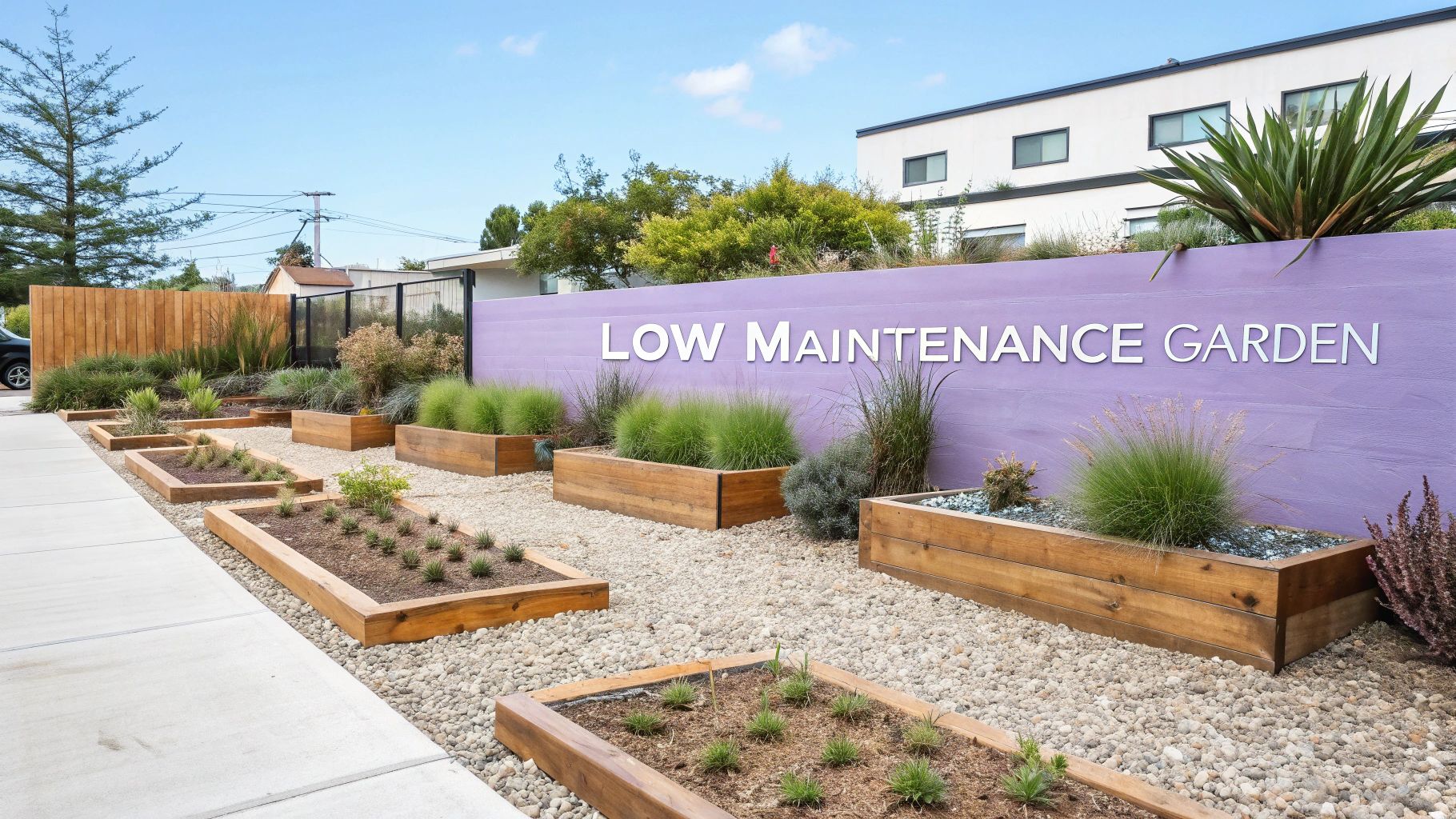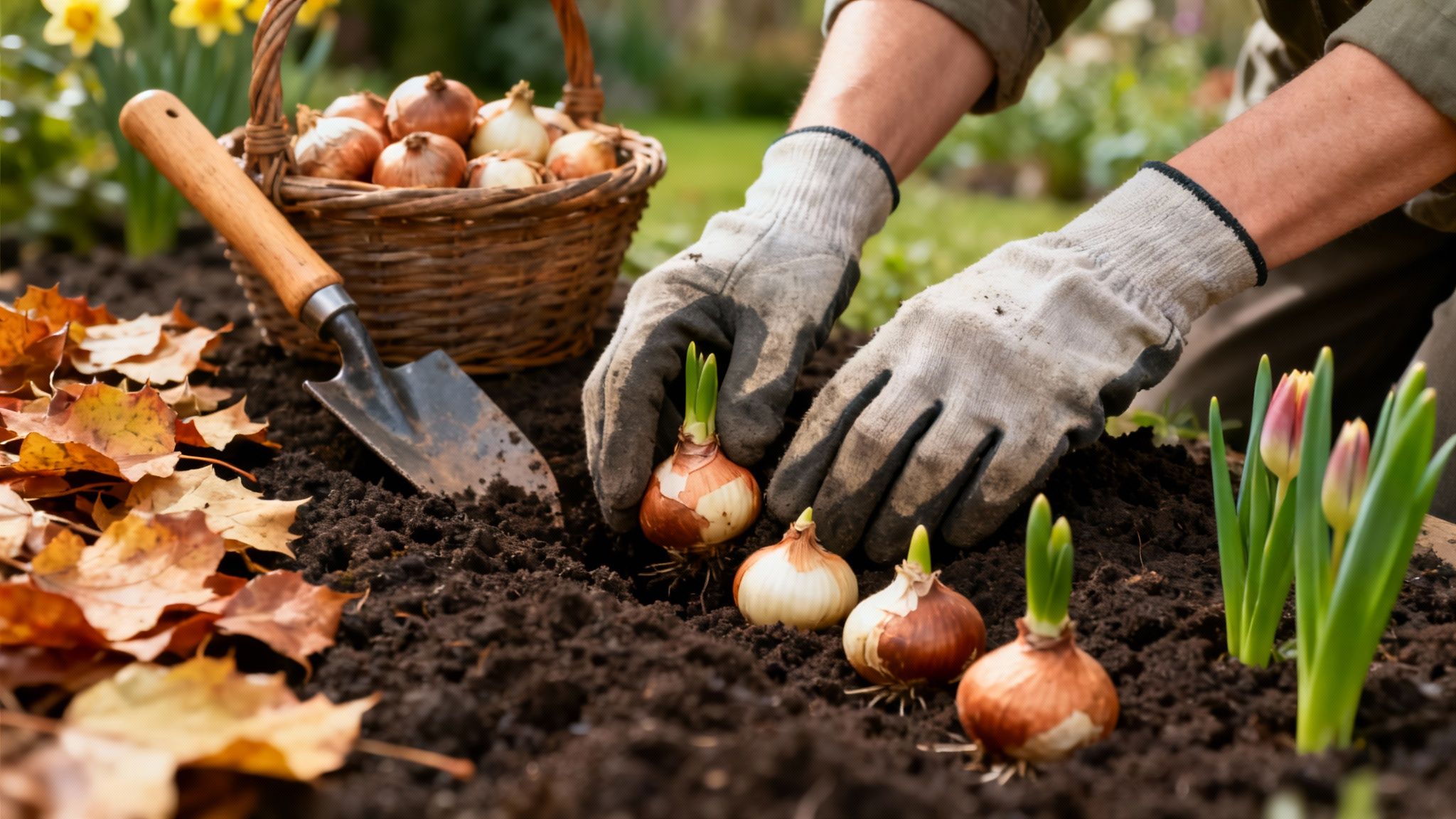Dreaming of a stunning garden that doesn't demand all your free time? Achieving a stylish, green oasis with minimal effort is more achievable than you might think. Many homeowners believe a beautiful garden requires endless hours of weeding, watering, and pruning, but modern gardening philosophies prove otherwise. The secret lies in smart design, strategic plant choices, and embracing techniques that work with nature, not against it. Whether you have a sprawling lawn or a compact urban balcony, the right approach can transform your outdoor space into a low-effort sanctuary.
This guide explores 10 innovative and practical low maintenance garden ideas, perfect for the busy British homeowner. We'll move beyond generic advice and delve into specific, actionable strategies, from leveraging native plants that thrive in our unique climate to implementing clever hardscaping that reduces upkeep. Prepare to discover how you can spend more time enjoying your garden and less time working in it. We will explore everything from the drought-tolerant beauty of xeriscaping to the simple efficiency of raised beds, providing you with a complete toolkit to create the garden you've always wanted, without the constant toil. Let's cultivate a space that offers both relaxation and style.
1. Native Plant Gardening: The Truly Local Solution
Creating a garden with plants indigenous to your local UK region is one of the most effective low maintenance garden ideas available. These plants have evolved over millennia to thrive in your specific climate, soil conditions, and rainfall patterns. Once established, they require minimal intervention, freeing you from constant watering, feeding, and pest control.
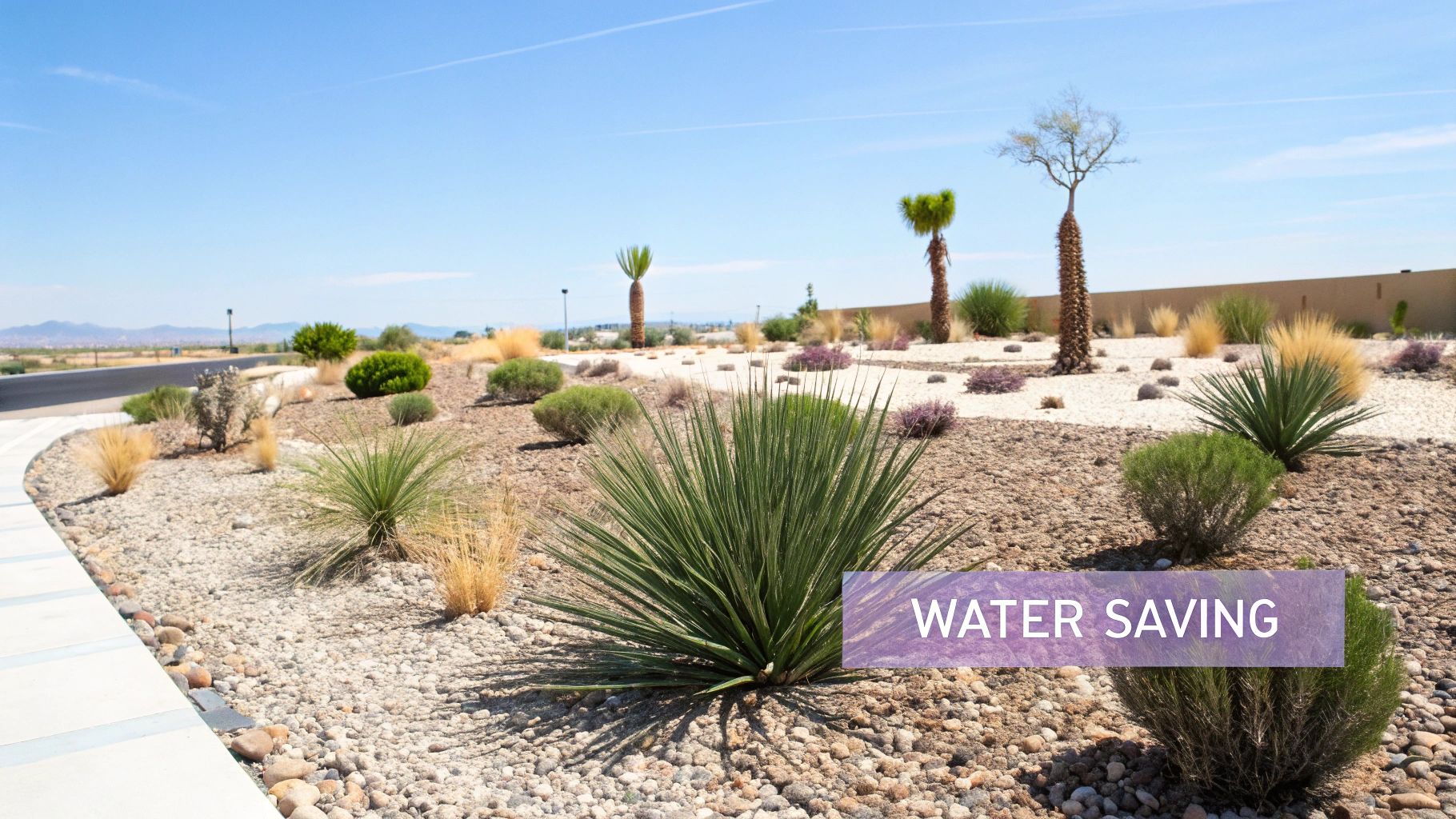
This approach not only saves you significant time but also forges a deep connection between your garden and the surrounding British landscape. It creates a resilient, self-sustaining ecosystem that supports local biodiversity, providing essential food and shelter for native pollinators and wildlife. Imagine a Cornish coastal garden flourishing with Sea Thrift (Armeria maritima), or a shady London plot adorned with the lush foliage of Hart's Tongue Fern (Asplenium scolopendrium) and elegant spires of Foxgloves (Digitalis purpurea).
How to Implement a Native Garden
- Start Small: Dedicate a single bed to native plants first. This allows you to observe what thrives in your specific soil and microclimate before a larger commitment.
- Plant in Autumn: Planting in the cooler, wetter months allows roots to establish deeply over winter, giving them a strong start for the following spring.
- Group Wisely: Arrange plants with similar light and water requirements together. This mimics their natural habitats and simplifies care, as you can treat an entire section uniformly.
- Mulch Generously: Apply a thick layer of organic mulch (like bark chips or leaf mould) during the first year. This is crucial for retaining soil moisture and suppressing weeds while your new plants get settled.
2. Xeriscaping: Designing for Drought Resistance
Xeriscaping is a smart landscaping approach that dramatically reduces or even eliminates the need for supplemental watering. By using drought-tolerant plants, efficient irrigation, and water-conserving design, it creates a stunning garden that thrives with minimal input. This is one of the most powerful low maintenance garden ideas, particularly for drier regions or water-conscious gardeners.
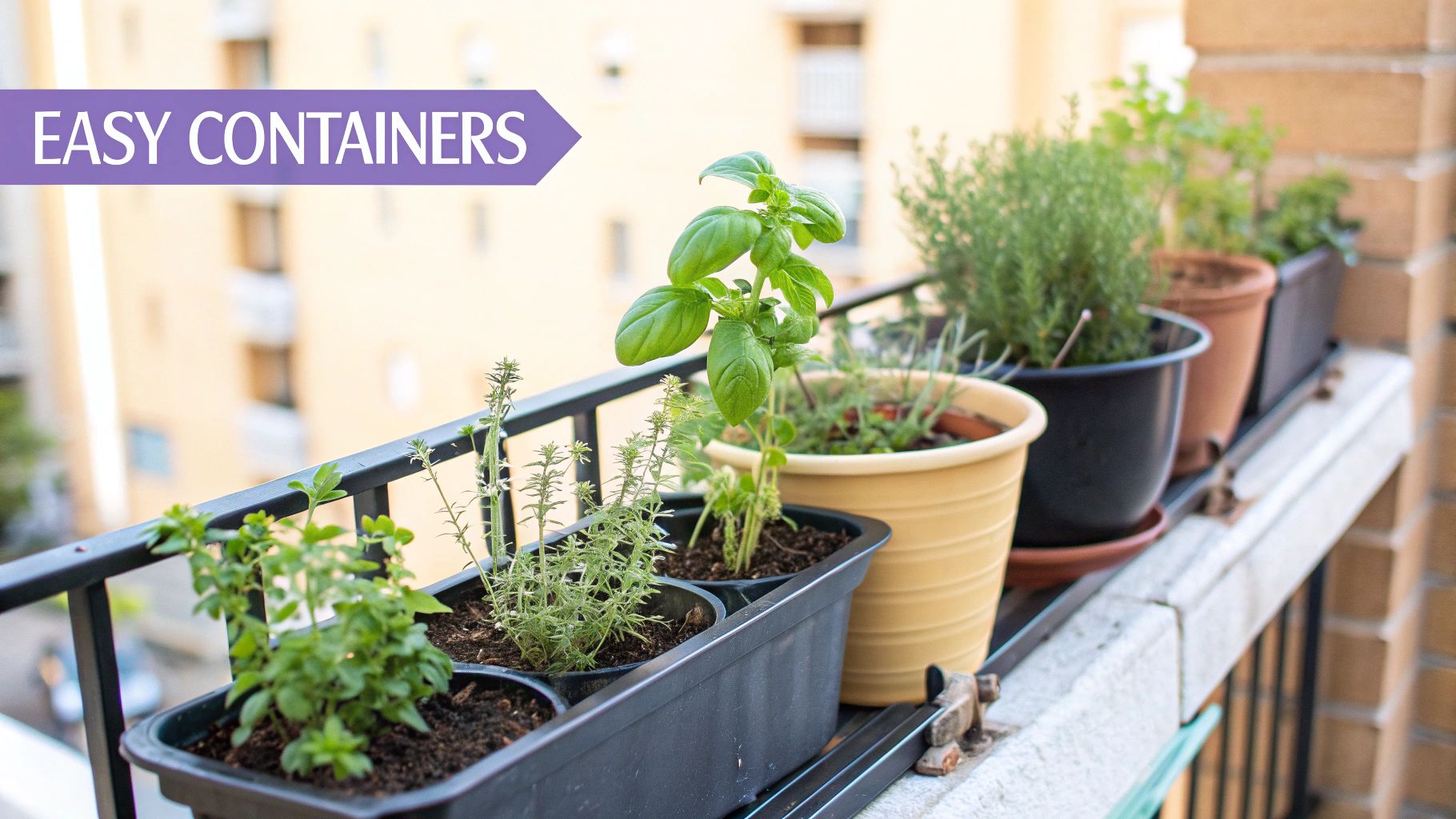
While pioneered in arid climates like Denver, its principles are highly adaptable to the UK, especially in sunny, free-draining areas or as a response to increasingly dry summers. Legendary gardener Beth Chatto’s famous Gravel Garden in Essex is a masterclass in this philosophy, showcasing how plants like Eryngium, Sedum, and Verbena bonariensis can create breathtaking displays without irrigation. The result is a resilient garden that saves water, money, and most importantly, your time.
How to Implement Xeriscaping
- Group by Water Needs: Arrange plants with similar water requirements together in "hydrozones". This prevents over- or under-watering and streamlines your care routine.
- Use Efficient Irrigation: If you do need to water, especially during establishment, opt for drip irrigation or soaker hoses. These deliver water directly to the plant roots, minimising evaporation and waste.
- Mulch Deeply: Apply a thick 7-10 cm layer of organic mulch or inorganic material like gravel. This suppresses weeds, retains soil moisture, and regulates soil temperature.
- Improve Your Soil: Amend your soil with organic matter like compost. This improves its structure and water-holding capacity, allowing it to act like a sponge and support plants through dry spells.
3. Raised Bed Gardening: Control and Comfort Combined
Raised bed gardening is a fantastic low maintenance garden idea that involves growing plants in soil elevated above ground level and contained within a frame. This approach gives you complete control over your growing environment, eliminating issues like poor native soil, compaction, and drainage problems. By creating a dedicated, nutrient-rich space, you set your plants up for success with far less ongoing effort.
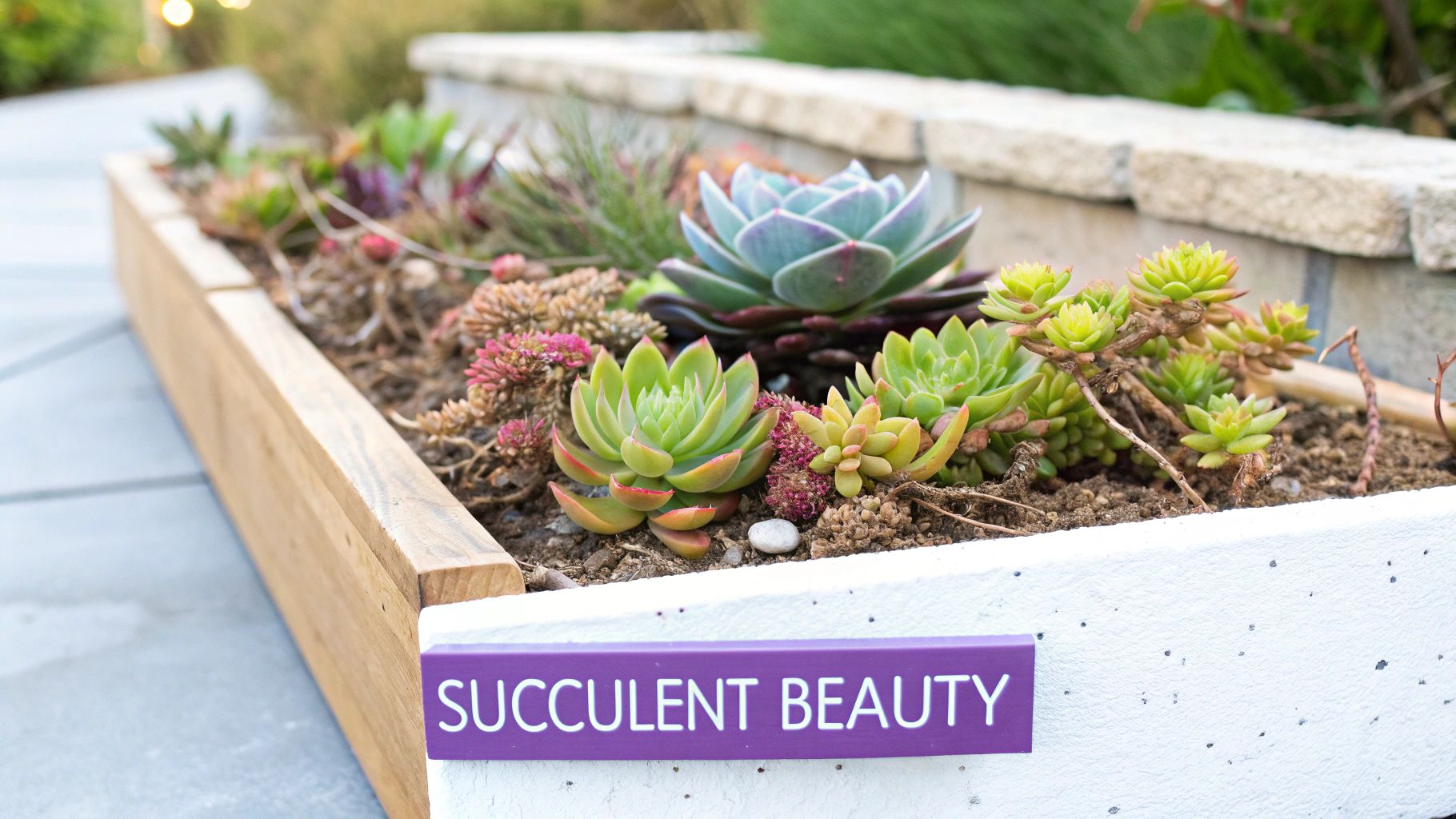
This method is not only practical but also accessible, reducing the physical strain of bending and kneeling. It naturally suppresses weeds from encroaching, as the contained soil acts as a barrier. From the organised plots of Mel Bartholomew's "Square Foot Gardening" to modern urban rooftop gardens, raised beds offer a tidy, productive, and easy-to-manage solution for any sized space. They are particularly effective for growing vegetables and cut flowers, where soil quality is paramount.
How to Implement Raised Beds
- Plan for Access: Construct beds no wider than 4 feet (1.2 metres). This ensures you can comfortably reach the centre from either side without stepping on and compacting the soil.
- Choose Durable Materials: Use naturally rot-resistant timber like untreated cedar or long-lasting composite materials. This avoids the need for frequent repairs or replacements.
- Create the Perfect Soil: Fill your beds with a high-quality mix of topsoil, compost, and other organic matter. This bespoke blend provides optimal aeration, drainage, and nutrients from the start.
- Automate Watering: Install soaker hoses or a drip irrigation system. This delivers water directly to the plant roots, minimising waste and saving you the daily task of hand-watering.
4. Ground Cover Gardens: A Living Mulch Solution
Swapping a traditional, high-maintenance lawn or empty beds for a carpet of low-growing, spreading plants is one of the smartest low maintenance garden ideas. Ground cover plants form a dense mat of foliage that effectively smothers weeds, reduces soil erosion, and conserves moisture, dramatically cutting down on your gardening chores. Once established, they create a beautiful, textured, living mulch that offers year-round visual interest.
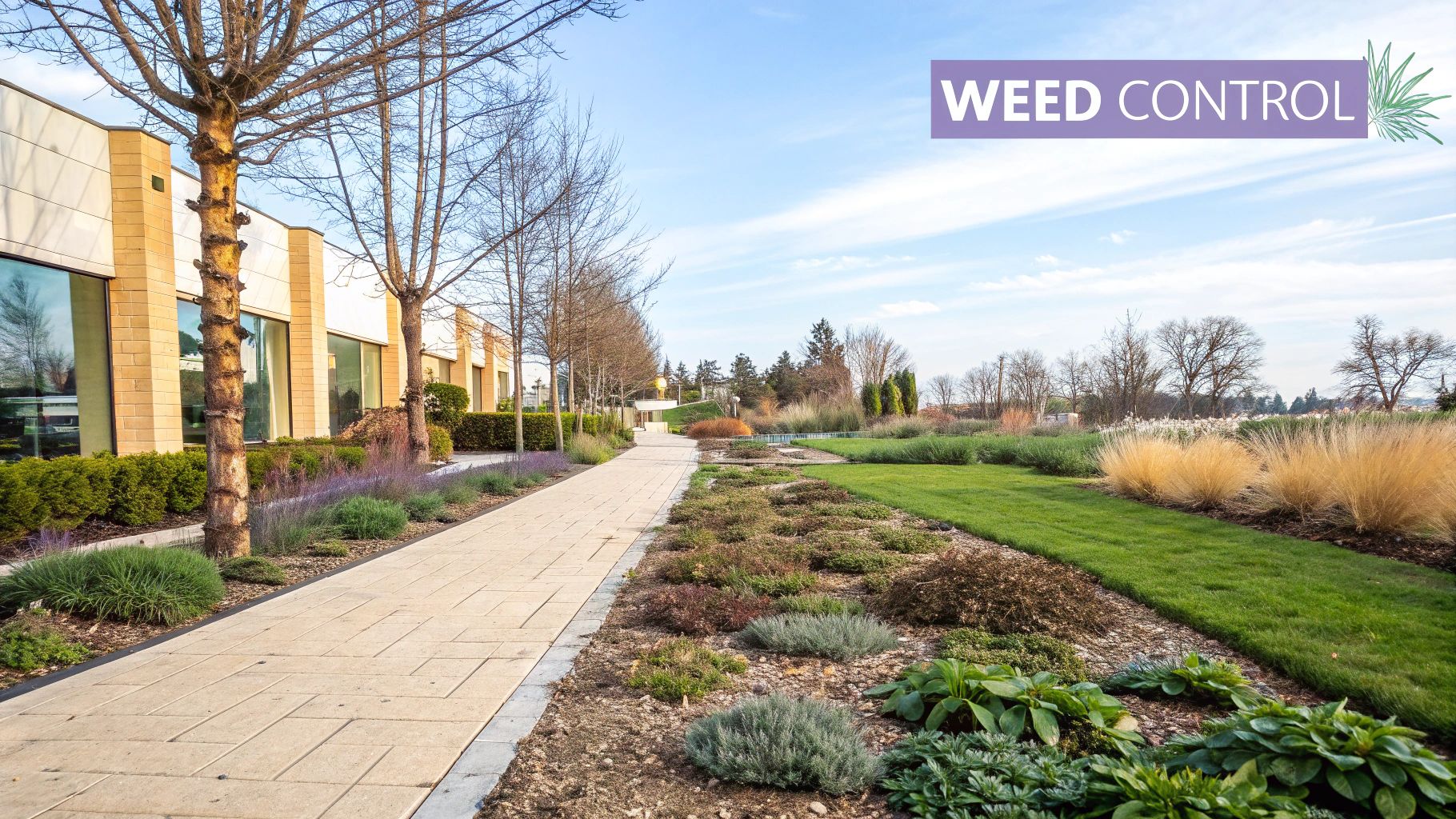
This approach, championed by historic garden designers and modern sustainable landscapers alike, provides a practical and attractive alternative to bare earth or thirsty grass. It works brilliantly for difficult areas, such as sloped banks, deep shade under trees, or hot, dry spots where little else will grow. Imagine a shady corner filled with the glossy leaves of Pachysandra terminalis, or sunny pathways softened by fragrant, walkable Creeping Thyme (Thymus serpyllum).
How to Implement a Ground Cover Garden
- Prepare the Ground Thoroughly: Before planting, remove all weeds and amend the soil with organic matter. This initial effort is key to long-term success, as removing weeds from an established ground cover is difficult.
- Plant for Quick Coverage: While following individual plant spacing guides, consider planting them slightly closer than their mature spread suggests. This helps them knit together faster, forming a weed-suppressing mat more quickly.
- Edge Your Beds: Install a clear border using metal edging, bricks, or stone. This is crucial for preventing more vigorous spreaders from migrating into lawns or other garden areas, keeping maintenance to a minimum.
- Water Diligently at First: Consistent watering during the first growing season is vital for the plants to establish a strong root system, which will make them much more resilient and drought-tolerant in the future.
5. Container Gardening: Flexible and Focused Care
Container gardening is an incredibly versatile and manageable approach, making it one of the best low maintenance garden ideas for any space, large or small. By growing plants in pots, troughs, and hanging baskets, you gain complete control over their environment, from the soil composition to the exact amount of water they receive. This method eliminates common garden chores like extensive digging and weeding, making it ideal for patios, balconies, and even indoor windowsills.
This contained approach not only simplifies maintenance but also allows for creative expression and flexibility. You can easily move pots to chase the sun, protect plants from frost, or simply rearrange your display for a fresh look. Imagine a vibrant collection of herbs just outside your kitchen door, a stunning architectural grass like Stipa tenuissima in a statement pot on the patio, or a cascade of colourful petunias brightening up an urban balcony. It’s gardening on your terms, perfectly contained and easy to manage.
How to Implement Container Gardening
- Prioritise Drainage: Always choose containers with sufficient drainage holes at the bottom. Without proper drainage, roots can become waterlogged and rot, which is the most common cause of failure in pot-grown plants.
- Use Potting Mix, Not Garden Soil: Fill your containers with a high-quality, peat-free potting compost. Garden soil is too heavy, compacts easily, and may contain weed seeds and diseases.
- Group for Impact and Efficiency: Arrange pots in clusters. This creates a more lush, impactful display and makes watering simpler, as you can tend to a whole group at once.
- Choose Appropriate Plants: Select plants that won't outgrow their container too quickly. Look for dwarf varieties of shrubs, compact perennials, and annuals, which are perfectly suited for life in a pot.
6. Ornamental Grass Gardens: Movement and Texture with Minimal Effort
Creating a garden dominated by ornamental grasses is an exceptional low maintenance garden idea, offering year-round structure, gentle movement, and captivating texture. Popularised by designers like Piet Oudolf, this approach mimics the natural beauty of wild prairies, creating a dynamic landscape that evolves through the seasons. Grasses provide visual interest from their fresh spring growth to their autumnal hues and frosted winter seed heads.
This style is perfect for busy homeowners who desire a sophisticated, modern aesthetic without the constant demands of traditional flower beds. Once established, many grasses are drought-tolerant and pest-resistant, requiring little more than a single annual cut-back. Imagine a swathe of feathery Stipa tenuissima catching the breeze, or the architectural plumes of Calamagrostis 'Karl Foerster' providing a vertical accent against a winter sky. It's a truly four-season, low-effort solution.
How to Implement an Ornamental Grass Garden
- Cut Back in Late Winter: The main task is cutting back deciduous grasses to a few inches from the ground in late winter or early spring, just before new growth appears. This clears the way for a fresh display.
- Plant in Spring: Planting new grasses in spring gives them a full growing season to establish strong root systems before winter arrives.
- Choose Clumping Varieties: Opt for clumping grasses like Miscanthus or Molinia over spreading types. Clumpers grow in neat mounds and won't aggressively take over your garden beds.
- Mix Heights and Textures: Create visual interest by combining tall, upright grasses with shorter, arching varieties. Mix fine, airy textures with bold, broad-leafed forms for a rich, layered look.
7. Succulent Gardens: Architectural and Drought-Tolerant Displays
For a garden that combines striking architectural form with exceptional resilience, succulent gardens are an outstanding choice. These plants store water in their leaves, stems, or roots, making them incredibly drought-tolerant and perfect for a low maintenance garden. Their unique textures, diverse shapes, and rich colour palettes, from deep burgundies to silvery blues, allow for the creation of visually stunning, almost sculptural, landscapes with minimal watering needs.
This approach creates a modern, water-wise garden that thrives on neglect once established. You can design a dedicated succulent bed, create a vibrant container display, or even build a vertical wall garden. From the popular rosettes of Echeverias and Sempervivums (Houseleeks) to the spiky forms of Agaves and Aloes, these plants offer endless design possibilities. They are particularly suited to sunny, dry spots in the garden where other plants might struggle to survive.
How to Implement a Succulent Garden
- Prioritise Drainage: This is the most critical factor. Ensure your pots have drainage holes, and amend garden soil with grit or perlite to create a fast-draining medium. Raised beds are an excellent option for controlling soil conditions.
- Water Deeply, Not Often: Mimic their natural desert environment. Water the soil thoroughly, then allow it to dry out completely before watering again. This encourages strong root development and prevents rot.
- Provide Frost Protection: While many succulents like Sempervivums are hardy in the UK, others are tender. For less hardy varieties, plant them in containers that can be easily moved indoors or into a greenhouse during winter.
- Maximise Sunlight: Most succulents thrive in full sun, which helps them develop their most vibrant colours. Aim for a spot that receives at least six hours of direct sunlight per day.
8. Automated Irrigation Systems: Water on Autopilot
Harnessing technology is one of the smartest low maintenance garden ideas for busy homeowners. Automated irrigation systems, including drip lines, soaker hoses, and smart sprinklers, deliver water directly to your plants’ roots with precision and minimal human intervention. This eliminates the daily chore of watering, prevents waste, and ensures your garden receives consistent moisture, even when you're on holiday.
This approach not only saves you countless hours but also promotes healthier, more resilient plants by avoiding the stress of irregular watering cycles. Imagine your vegetable patch thriving with a drip irrigation system delivering a slow, steady supply of water, or your lawn remaining lush thanks to a smart controller that automatically adjusts its schedule based on local weather forecasts. Systems from brands like Rain Bird and smart controllers from Rachio make this level of automation easily accessible.
How to Implement Automated Irrigation
- Choose the Right System: Use drip irrigation or soaker hoses for garden beds, containers, and hedgerows to deliver water directly to the soil and minimise evaporation. Reserve sprinklers for larger lawn areas.
- Program for Early Mornings: Set your system to water between 4 am and 8 am. Watering during these cool, calm hours reduces water loss to wind and evaporation, allowing it to soak deep into the soil.
- Install a Rain Sensor: A rain shut-off device is a simple but essential addition. It automatically pauses your programmed watering schedule when it detects sufficient rainfall, conserving water and preventing overwatering.
- Perform Regular Checks: At the start of each growing season, inspect your system for clogged nozzles, leaks, or misaligned sprinkler heads to ensure it operates efficiently and effectively throughout the year.
9. Perennial Gardens: The Gift That Keeps on Giving
Designing a garden around perennial plants is a cornerstone of low maintenance garden ideas, as these hardy plants return year after year, saving you the annual cost and effort of replanting. Unlike annuals that complete their life cycle in one season, perennials establish deep root systems, becoming more resilient and beautiful with each passing year. They provide reliable structure and a predictable succession of colour and texture throughout the seasons.

This long-term approach allows you to create a sophisticated, layered garden that evolves over time. Think of the romantic, overflowing beds of an English cottage garden, popularised by designers like Gertrude Jekyll, or the modern, naturalistic meadows championed by Piet Oudolf. These styles rely on a backbone of robust perennials like Salvia, Rudbeckia, and ornamental grasses to deliver stunning visual impact with minimal ongoing intervention. A well-planned perennial garden rewards you with an ever-changing display for a one-time planting effort.
How to Implement a Perennial Garden
- Plan for Maturity: Research the final size and spread of each plant. Spacing them correctly from the start prevents overcrowding and the need to move them later.
- Plant in Drifts: For a naturalistic look, group perennials in odd numbers (3, 5, or 7) and arrange them in organic, flowing shapes rather than rigid rows.
- Sequence the Bloom: Select a mix of plants with different flowering times: early spring (Hellebores), summer (Geraniums), and late autumn (Asters). This ensures your garden has visual interest for most of the year.
- Mulch Heavily: In the first year, apply a generous layer of organic mulch. This is vital for suppressing weeds, conserving moisture, and protecting the young plants as their roots get established.
10. Mulched Garden Beds: The Ultimate Work-Saver
Applying a thick layer of mulch is one of the single most impactful low maintenance garden ideas you can implement. Mulch is simply a material spread over the soil surface, acting as a protective blanket. This straightforward technique dramatically reduces garden chores by suppressing weed growth, retaining precious soil moisture, and regulating soil temperature, creating a stable and healthy environment for your plants.
Pioneered by figures like Ruth Stout in her "no-work" gardening method, mulching eliminates the need for constant weeding and frequent watering. Imagine your perennial borders covered in a rich, dark layer of bark chips, which slowly breaks down to improve the soil. Alternatively, consider a modern xeriscape garden where gravel mulch creates a clean aesthetic while keeping moisture locked in for drought-tolerant plants like sedums and grasses. It’s a versatile solution for a healthier, less demanding garden.
How to Implement Mulched Beds
- Choose Your Mulch: Select a mulch that suits your garden's needs. Organic options like bark chips, compost, or leaf mould improve soil structure over time. Inorganic mulches like gravel or slate chippings offer a permanent, decorative finish ideal for alpine or Mediterranean-style planting.
- Apply the Right Depth: Spread your chosen mulch to a depth of 5-10cm (2-4 inches). This is thick enough to block sunlight from reaching weed seeds and to effectively insulate the soil.
- Keep Stems Clear: When applying mulch, ensure you leave a small gap around the base of plant stems and tree trunks. Piling mulch directly against them can trap moisture and may lead to rot.
- Top Up Annually: Organic mulches will decompose over the year, enriching your soil. Plan to refresh the layer each spring to maintain its depth and weed-suppressing benefits.
Low Maintenance Garden Ideas Comparison
Cultivating Your Low-Maintenance Haven
Creating a beautiful garden shouldn't feel like a second job. As we've explored, the secret to a stunning yet manageable outdoor space lies in smart design and strategic choices, not in endless hours of labour. The journey towards an effortless garden is about working in harmony with nature, selecting elements that are inherently resilient, and leveraging modern solutions to minimise your workload. These are the core principles behind the most successful low maintenance garden ideas.
By embracing the concepts we've discussed, you transition from a reactive gardener, constantly fighting weeds and watering plants, to a proactive designer who curates a self-sustaining ecosystem. You're no longer just planting; you're building a foundation for lasting beauty.
Key Takeaways for an Effortless Garden
Let's distill our exploration into a few core principles. The most impactful low-maintenance strategies revolve around a central theme: thoughtful planning.
- Plant Smarter, Not Harder: Prioritise plants that are naturally suited to your environment. Native species, hardy perennials, succulents, and ornamental grasses are champions of resilience. They demand less water, resist local pests, and thrive without constant fussing.
- Work with Your Landscape, Not Against It: Techniques like xeriscaping teach us to embrace our climate's unique conditions. Instead of trying to force a water-hungry lawn to grow in a dry area, you can create a gorgeous, drought-tolerant tapestry of gravel, rock, and hardy plants.
- Invest in Time-Saving Infrastructure: The initial effort of setting up raised beds, installing an automated irrigation system, or laying a thick layer of mulch pays dividends for years to come. These systems handle the repetitive, time-consuming tasks for you, freeing you up to enjoy the creative aspects of gardening.
Your Next Steps to a Low-Maintenance Lifestyle
Feeling inspired? The best way to begin is by taking small, deliberate steps. Don't feel pressured to overhaul your entire garden overnight. Instead, choose one or two ideas that resonate most with your space and lifestyle.
- Assess Your Space: Spend some time observing your garden. Where does the sun hit? What is your soil like? Answering these questions will guide you towards the most suitable plants and strategies.
- Start with a Single Project: Perhaps begin by converting one problematic flowerbed into a mulched perennial garden. Or, start a small container garden on your patio to experiment with succulents and automated watering.
- Plan for the Long Term: A low-maintenance garden is a long-term investment in your home and wellbeing. By choosing the right plants and systems from the outset, you are cultivating a sanctuary that will mature beautifully, requiring less and less from you as it becomes established.
Ultimately, the goal of these low maintenance garden ideas is to craft a personal haven that enriches your life rather than complicates it. It’s about creating a space where you can relax, entertain, and connect with nature on your own terms. By making these intelligent, sustainable choices, you're not just saving time; you're investing in a more peaceful, beautiful, and enjoyable lifestyle. Your perfect, easy-care outdoor retreat is well within reach.

